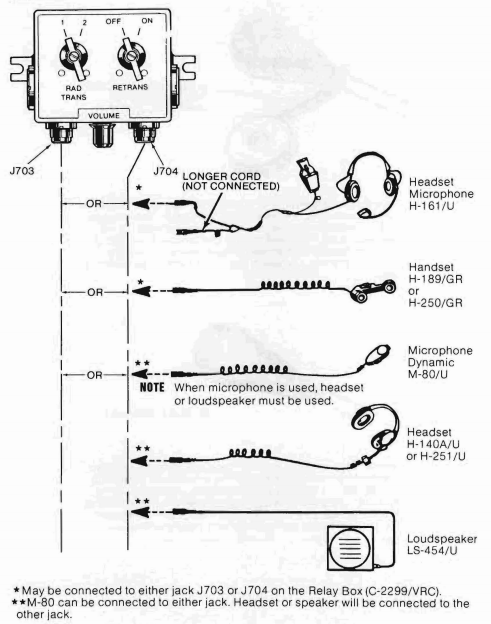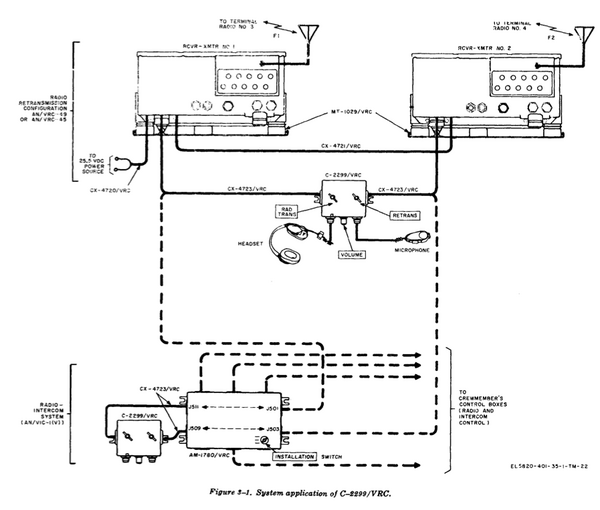Difference between revisions of "C-2299~VRC"
RadioNerds (talk | contribs) |
|||
| (18 intermediate revisions by 2 users not shown) | |||
| Line 1: | Line 1: | ||
| + | ==Overview== | ||
The C-2299/VRC is used between receiver-transmitters of Radio Sets AN/VRC-49 and AN/VRC- 45 to provide automatic retransmission of signals between radio sets that are too far apart to communicate directly with each other. | The C-2299/VRC is used between receiver-transmitters of Radio Sets AN/VRC-49 and AN/VRC- 45 to provide automatic retransmission of signals between radio sets that are too far apart to communicate directly with each other. | ||
| − | + | Receiver-Transmitter No. 1 and terminal radio No. 2 operate on one frequency (F1), and receiver-transmitter No. 2 and terminal radio No. 4 operate on another frequency (F2). For retransmission operation, the radios in the system must operate on squelch mode. | |
| − | + | When the C-2299/VRC RETRANS switch is set to ON, the retransmission of signals and keying control are automatically passed through the C-2299/VRC to the retransmission site receiver-transmitters. When the C-2299/VRC RE- TRANS switch is set to OFF, the user has control of the two receiver-transmitters from the audio accessories connected to the C-2299/VRC. In position 1 of RAD TRANS switch, receiver- transmitter No. 1 is controlled; in position 2 of RAD TRANS switch, receiver-transmitter No. 2 is controlled. | |
| − | + | Audio accessories can be connected to the C-2299/VRC to enable the radio user to communicate through the retransmission site receiver- transmitters with the terminal radios. When the C-2299/VRC RETRANS switch is set to ON, the radio user cannot communicate with the terminal radios, but can hear the transmission occurring between the terminal radios. | |
| − | + | However, when the C-2299/VRC is connected to the AM-1780/VRC of the radio-intercom system the receiving circuits of the receiver- transmitters No. 1 and 2 are not available at the C-2299/VRC. Thus, radio communication is conducted from the crew member control boxes. Also, for the retransmission operation, the INSTALLATION switch of the AM-1780/VRC is set to the RETRANS position. Under these conditions, the retransmission signals are available on the ALL position of the crew member control boxes. | |
| + | ===Use as a remote keying station for VRC-12 series radios=== | ||
| + | The C-2299 can be used as a remote keying station for the VRC-12 series radios. When hooked to the MT-1029, the C-2299 allows remote use of the microphone and speaker for up to two radios. A typical example is for the C-2299 to be installed in the front cab of a vehicle while the radios remain i the rear, or under the seat. | ||
| − | + | ==Use as an auxiliary interface for microphones and headsets== | |
| + | The C-2299 is the only way to properly use a microphone directly on the VIC-1. | ||
| + | [[File:C-2299_additional_accessories.png]] | ||
| − | + | ==Images== | |
| + | <gallery widths=100px heights=100px perrow=5> | ||
| + | File:C2299-Front.JPG | ||
| + | File:C2299-bottom.JPG | ||
| + | </gallery> | ||
| + | |||
| + | |||
| + | |||
| + | ==Example Hookup== | ||
| + | [[File:C-2299 hookup example.png|600px]] | ||
| + | |||
| + | |||
| + | |||
| + | ==Schematics== | ||
| + | <gallery widths=100px heights=100px perrow=5> | ||
| + | File:C-2299 schematic.png | ||
| + | File:C-2299 wiring.png | ||
| + | </gallery> | ||
| + | |||
| + | |||
| + | |||
| + | |||
| + | ==Additional Files== | ||
| + | ;{{pdf|TM_11-5820-401-35-1.pdf|TM 11-5820-401-35-1}} | ||
| + | :DIRECT SUPPORT, GENERAL SUPPORT, AND DEPOT MAINTENANCE MANUAL INCLUDING REPAIR PARTS AND SPECIAL TOOLS LISTS | ||
| + | ::CONTROL, FREQUENCY SELECTOR C-2742/VRC | ||
| + | ::CONTROL, RADIO SET C-2299/VRC | ||
| + | ::April 1973 | ||
| + | |||
| + | [[Category:Military/Intercoms]] | ||
| + | {{DISPLAYTITLE:C-2299/VRC}} | ||
Latest revision as of 04:22, 29 November 2013
Contents
Overview
The C-2299/VRC is used between receiver-transmitters of Radio Sets AN/VRC-49 and AN/VRC- 45 to provide automatic retransmission of signals between radio sets that are too far apart to communicate directly with each other.
Receiver-Transmitter No. 1 and terminal radio No. 2 operate on one frequency (F1), and receiver-transmitter No. 2 and terminal radio No. 4 operate on another frequency (F2). For retransmission operation, the radios in the system must operate on squelch mode.
When the C-2299/VRC RETRANS switch is set to ON, the retransmission of signals and keying control are automatically passed through the C-2299/VRC to the retransmission site receiver-transmitters. When the C-2299/VRC RE- TRANS switch is set to OFF, the user has control of the two receiver-transmitters from the audio accessories connected to the C-2299/VRC. In position 1 of RAD TRANS switch, receiver- transmitter No. 1 is controlled; in position 2 of RAD TRANS switch, receiver-transmitter No. 2 is controlled.
Audio accessories can be connected to the C-2299/VRC to enable the radio user to communicate through the retransmission site receiver- transmitters with the terminal radios. When the C-2299/VRC RETRANS switch is set to ON, the radio user cannot communicate with the terminal radios, but can hear the transmission occurring between the terminal radios.
However, when the C-2299/VRC is connected to the AM-1780/VRC of the radio-intercom system the receiving circuits of the receiver- transmitters No. 1 and 2 are not available at the C-2299/VRC. Thus, radio communication is conducted from the crew member control boxes. Also, for the retransmission operation, the INSTALLATION switch of the AM-1780/VRC is set to the RETRANS position. Under these conditions, the retransmission signals are available on the ALL position of the crew member control boxes.
Use as a remote keying station for VRC-12 series radios
The C-2299 can be used as a remote keying station for the VRC-12 series radios. When hooked to the MT-1029, the C-2299 allows remote use of the microphone and speaker for up to two radios. A typical example is for the C-2299 to be installed in the front cab of a vehicle while the radios remain i the rear, or under the seat.
Use as an auxiliary interface for microphones and headsets
The C-2299 is the only way to properly use a microphone directly on the VIC-1.
Images
Example Hookup
Schematics
Additional Files
- DIRECT SUPPORT, GENERAL SUPPORT, AND DEPOT MAINTENANCE MANUAL INCLUDING REPAIR PARTS AND SPECIAL TOOLS LISTS
- CONTROL, FREQUENCY SELECTOR C-2742/VRC
- CONTROL, RADIO SET C-2299/VRC
- April 1973





